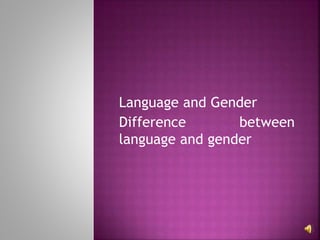
Language and Gender
- 1. Language and Gender Difference between language and gender
- 2. Social dialect research focuses on difference between women’s and men’s speech in the areas of pronunciation and morphology with some attention to syntactic constructions (such as multiple negations). Brend (1975) claims that the intonation pattern of men and women vary. Robin Lakoff shifts the focus of research on gender difference to syntax, semantics, and style. She suggests that women’s subordinate social status in American society is reflected in the language used about them. She identifies a number of linguistics features which she claims are used more often by women than men, and which in her opinion express uncertainty and lack of confidence.
- 3. According to Robin Lakoff, Women’s use of both Hedging and boosting devices present the lack of confidence. Lakoff suggests that women’s speech is characterized by linguistic features such as following: 1) Lexical hedges or fillers, e.g. you know, you see, sort of, well. 2) Tag questions, e.g. She’s very nice, isn’t she? 3) Rising intonation on declaratives, e.g. it’s really good? 4) ‘Empty’ adjectives, e.g. divine, charming, cute. 5) Precise color terms, e.g. magenta, aquamarine. 6) Intensifiers such as just , and so ,e.g. I like him so much. 7) ‘Hypercorrect’ grammar, e.g. consistent use of standard verb forms 8) Avoidance of strong swears words, e.g. fudge, my goodness.
- 4. 9) Emphatic stress, e.g. it is a BRILLANT performance. Here, all are hedging devices except the boosting devices –intensifiers and emphatics stress. Lakoff argues that women’s use hedging device to express uncertainty, and they use boosting devices to persuade their addressee to take them seriously. Women boost the force of their utterances because they think that otherwise they will not be heard or paid attention to. So, according to Lakoff, both hedges and boosters reflect women’s lack of confidence. Lakoff also says that women may answer a question with a statement employing the rising intonation pattern usually associated with making a question rather than the falling intonation pattern associated with making a firm statement.
- 5. Women use certain patterns associated with surprise and politeness more often than men. Women's language was described as weak, unassertive, tentative, and women were presented as losers, as victims (Coates 1998:413). Holmes (1995) characterizes women’s speech as more polite than men’s. Researchers argue that the women use more tags than the men. But they do not use them for the same purposes as the men. Women put more emphasis than men on the polite or affective functions of tags, using them as facilitative positive politeness devices. Men, on the other hand, use tags for the expression of uncertainty
- 6. In a study of Mayan community in Maxico, for instance, overall the women used more politeness device than the men, so the pattern seemed to resemble the Western pattern. But, increasingly, the men used far fewer politeness forms to each other than to women. So, male talk to males was relatively plain an unmodified. In this community, ‘men’s talk’ could be seen as the unusual variety rather than women’s talk.
- 7. There are many features of interaction which differentiate the talk of women and men. Women tend to interrupt less in conversation and “to be more attentive listeners, concerned to ensure others get a chance to contribute” than men (Holmes 1995: 67). Despite the widespread stereotype of women as the talkative sex, and proverbs which characterize women as garrulous. Women’s tongues are like lambs’ tails, they never still’ most of the research evidence points outs the other way. In a wide range of contexts, particularly non-private ones such as television interviews, staff meetings and conference discussions, where talking may increase your status, men dominate the talking time. In the same gender interruptions are pretty evenly distributed between speakers. In same-sex pairs: a) Men argue more with other men, b) Women are more dramatic with other women.
- 8. A number of studies show that in cross-sex interactions, men frequently interrupt women but women much less frequently interrupt men. In cross-sex conversation, women ask more questions, encourage others to speak, use more signals like- ‘mm hmm’ to encourage others to continue speaking, use more instances of you and we, and do not protest as much as men when interrupted. Men interrupt more, challenge more, dispute, and ignore more, try to control what topics are discussed, and make categorical statement. That is, in the cross-sex interactional patterns in conversation, men and women seem to exhibit the power relationship that exists in society, with men dominating and women subservient.
- 9. There is no doubt that men are still doing most of the interrupting. In other contexts, too, it has been found that men interrupt others more than women do. In departmental meetings and doctor-patient interactions, for instance, the pattern holds. Women get interrupted more than men, regardless of whether they are the doctors or the patients. In exchanges between patients and children, fathers do most of the interrupting, and daughters are interrupted most- both by their mothers and their fathers. However, most of the men speak more often and for longer than most of the women. Most of men interrupt more than the women. While men and women are both guilty of interrupting.
- 10. There are some significant differences: • Men interrupt, overall, more often than women. • Men interrupt other women more often than they interrupt men. • Men are more successful at taking and maintaining the floor. • Women’s interruptions take the form of questions and/or supportive statements (yeah, right, I see, is that so, etc.). Holmes (1992), on the other hand, found that in doctor-patient conversations female doctors were interrupted more often than male physicians. In addition, in business organizations, men but not women tended to dominate the interactions. West (1998) came to similar conclusions in her study of interaction between doctors and patients.
